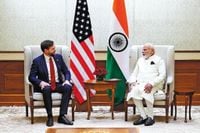In a significant diplomatic development, Prime Minister Narendra Modi and U.S. Vice President JD Vance announced a trade roadmap in New Delhi, marking a key breakthrough in U.S.-India relations. The agreement, hailed as "a critical step forward" by U.S. Trade Representative Jamieson Greer, aims to pave the way for a Bilateral Trade Agreement (BTA) between the two nations, which are among the largest democracies in the world.
The newly established Terms of Reference are designed to create a framework for reciprocal trade, tariff reduction, and expanded market access, indicating a high level of ambition from both sides. However, this optimism is tempered by a complex landscape, marked by longstanding issues, political risks, and the resurgence of protectionist policies reminiscent of the Trump administration.
In 2024, the bilateral goods trade between the U.S. and India reached an impressive $129.2 billion. Yet, the U.S. faced a $45.7 billion trade deficit with India, a figure that has risen by 5.1% from the previous year, raising concerns within the Trump administration. "On April 2, 2025, Liberation Day, President Trump imposed a 10% tariff on all countries and individualized reciprocal higher tariffs on nations with which the U.S. has the largest trade deficits in order to level the playing field," stated a USTR Fact Sheet regarding ongoing negotiations with India.
This move is part of the administration's "America First" policy, which aims to safeguard U.S. jobs and manufacturers but complicates trade negotiations with allies. A particular point of contention is India's high average applied tariff rate of 17%, with agricultural imports facing a steep 39% duty. In contrast, the U.S. maintains an average tariff of just 3.3%, with only 5% on agricultural goods.
American exporters, especially in agriculture and dairy, have long sought greater access to the Indian market. However, with over half of India's population linked to agriculture, reducing duties on farm products presents a politically sensitive challenge. Greer acknowledged that "significant trade barriers with India remain, including high tariffs, technical barriers to trade, and regulatory restrictions across services, industrial, and agricultural sectors."
Another layer of complexity is added by the sensitive issue of immigration. Indian negotiators are particularly concerned about the future of the H1B visa program, which is vital for India's IT and tech workforce. While immigration is not officially part of the trade discussions, the prior clampdown on skilled visas by the Trump administration has created trust issues. Without assurances on immigration policies, India is unlikely to offer major concessions in trade negotiations. As a former Indian trade negotiator noted, "Visas may not be in the fine print, but they’re very much on the table politically. And without predictability, there’s little appetite for risk."
Non-tariff and regulatory barriers further complicate the situation. U.S. businesses often cite India’s convoluted rules regarding standards, testing, and certification as significant deterrents. Conversely, Indian firms encounter barriers in U.S. pharmaceuticals, digital services, and public procurement, necessitating deep, sustained negotiations to resolve these issues and build trust that agreements will not be unilaterally reversed.
The fear of unilateral actions, reminiscent of Trump’s previous term—where he walked away from multilateral agreements and threatened allies with tariffs—still looms large in the minds of Indian negotiators. For India, the stakes are high; it’s not just about navigating tough negotiations but also about ensuring that any deal reached will hold firm amid shifting U.S. political landscapes.
Despite these challenges, the incentives for both nations are compelling. For the U.S., India represents a crucial partner in efforts to diversify supply chains away from China and to shape global trade rules. For India, access to U.S. markets and technology investment is essential for its economic growth and strategic autonomy. However, aligning these interests into a durable trade pact will be no small feat, especially given the volatile political climates in both countries.
Analysts like Brahma Chellaney, a prominent geostrategist and author, argue that "Trump’s return to power is not merely restoring the U.S.-India relationship—it is revitalizing it with fresh urgency, grounded in mutual interests and shared concerns." Others caution that while the Modi-Vance trade roadmap is a welcome development, it is still too early to celebrate a successful deal.
During his visit, Vice President Vance emphasized the importance of stronger U.S.-India relations in a speech delivered in Jaipur. He underscored that both countries need to collaborate effectively to secure a "prosperous and peaceful" 21st century. Vance remarked, "If we fail to work together successfully, the 21st century could be a very dark time for all of humanity." His comments came on the heels of discussions with Modi about advancing a bilateral trade deal, which India hopes will help it avoid higher tariffs.
As negotiations progress, India is moving swiftly to finalize trade agreements during Trump’s 90-day pause on higher tariffs, which ends on July 9, 2025. Prior to this pause, India was facing a potential 27% tariff from the U.S. Vance noted that the two nations have finalized the terms of reference for negotiations, a significant step toward realizing the trade vision shared by Trump and Modi.
Moreover, Vance expressed a desire for the U.S. to increase its sales of energy and defense equipment to India, further solidifying the partnership between the two nations. He acknowledged Modi's reputation as a "tough negotiator" and highlighted the importance of defense collaboration between the two countries.
In personal remarks, Vance shared a touching anecdote about his son, Ewan, who expressed a desire to live in India after meeting Modi. Vance's family, who accompanied him on this trip, has been engaging with Indian culture, visiting significant landmarks such as the Amber Fort and the Taj Mahal. This visit marks the first time in over a decade that a U.S. Vice President has traveled to India, emphasizing the renewed focus on strengthening bilateral ties.
As both nations navigate the complexities of trade negotiations, the hope remains that mutual interests will prevail, leading to a successful and lasting agreement.








